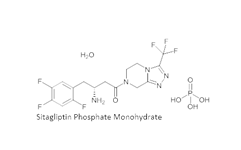
CAS Number: 654671-77-9
Formula: C16H20F6N5O6P
Molecular Weight: 523.32 g/mol
Method of Analysis: In house
Application: Sitagliptin is an oral antihyperglycemic drug of the dipeptidyl peptidase-4 inhibitor class. It works by increasing the amount of insulin released, and decreasing the amount of sugar made, by the body
Mechanism:
Sitagliptin is a member of a class of oral anti-hyperglycaemic agents called dipeptidyl peptidase 4 (DPP-4) inhibitors. It is a highly selective DPP-4 inhibitor and improves glycaemic control in patients with type 2 diabetes by enhancing the levels of active incretin hormones. Incretin hormones, including glucagon-like peptide-1 (GLP-1) and glucose-dependent insulinotropic polypeptide (GIP), are released by the intestine throughout the day, and levels are increased in response to a meal. The incretins are part of an endogenous system involved in the physiologic regulation of glucose homeostasis. When blood glucose concentrations are normal or elevated, GLP-1 and GIP increase insulin synthesis and release from pancreatic beta cells by intracellular signalling pathways involving cyclic AMP. Treatment with GLP-1 or with DPP-4 inhibitors in animal models of type 2 diabetes has been demonstrated to improve beta cell responsiveness to glucose and stimulate insulin biosynthesis and release. With higher insulin levels, tissue glucose uptake is enhanced. In addition,GLP-1 lowers glucagon secretion from pancreatic alpha cells. Decreased glucagon concentrations, along with higher insulin levels, lead to reduced hepatic glucose production, resulting in a decrease in blood glucose levels. The effects of GLP-1 and GIP are glucose dependent such that when blood glucose concentrations are low, stimulation of insulin release and suppression of glucagon secretion by GLP-1 are not observed. For both GLP-1 and GIP, stimulation of insulin release is enhanced as glucose rises above normal concentrations. Further, GLP-1 does not impair the normal glucagon response to hypoglycaemia. The activity of GLP-1 and GIP is limited by the DPP-4 enzyme, which rapidly hydrolyses the incretin hormones to produce inactive products. Sitagliptin prevents the hydrolysis of incretin hormones by DPP-4, thereby increasing plasma concentrations of the active forms of GLP-1 and GIP. By enhancing active incretin levels, sitagliptin increases insulin release and decreases glucagon levels in a glucose-dependent manner. In patients with type 2 diabetes with hyperglycaemia, these changes in insulin and glucagon levels lead to lower haemoglobin A1c (HbA1c) levels and lower fasting and postprandial glucose concentrations. The glucose-dependent mechanism of sitagliptin is distinct from the mechanism of sulfonylureas, which increase insulin secretion even when glucose levels are low and can lead to hypoglycaemia in patients with type 2 diabetes and in normal subjects. Sitagliptin is a potent and highly selective inhibitor of the enzyme DPP-4 and does not inhibit the closely-related enzymes DPP-8 or DPP-9 at therapeutic concentrations
Storage conditions: Room temperature
Packaging: polyethylene nylon plastic bag